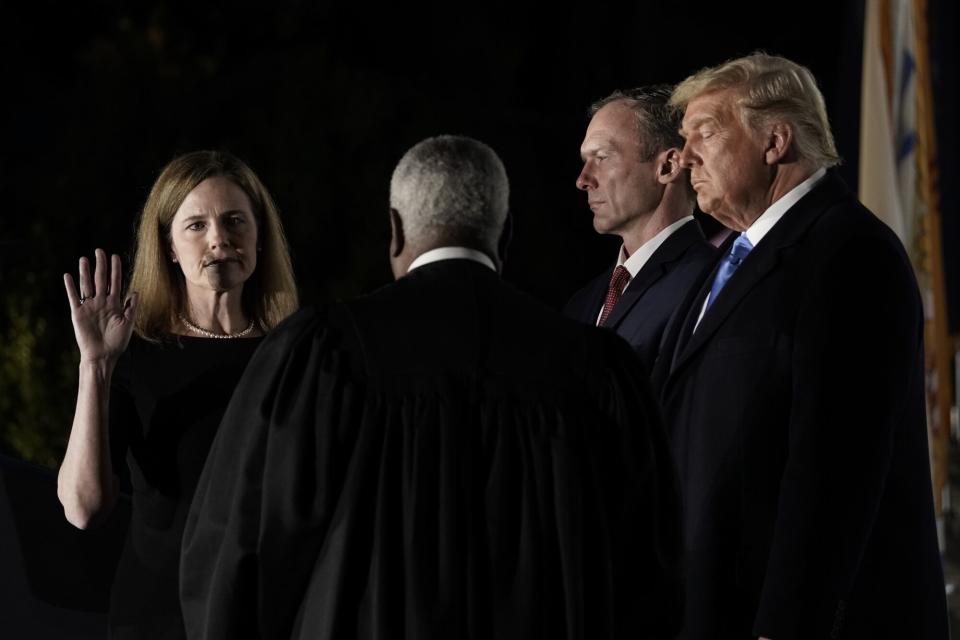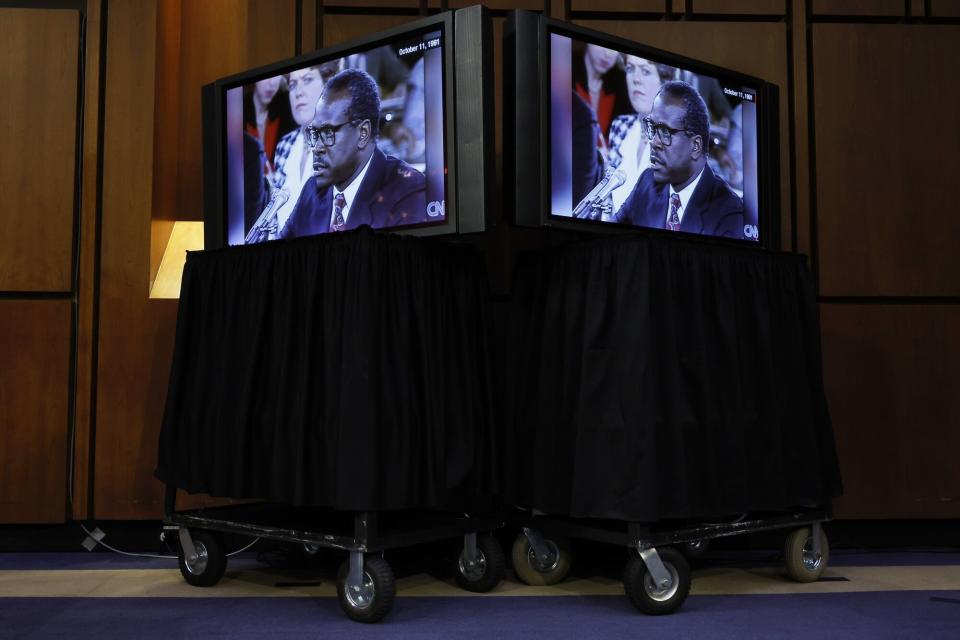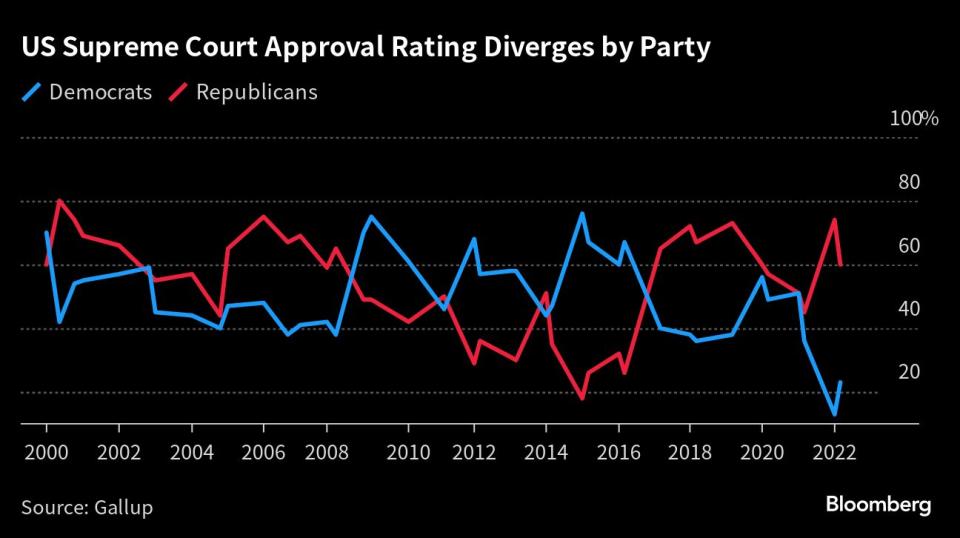An Aggressive Supreme Court Reshapes the US as Its Standing Erodes
- Oops!Something went wrong.Please try again later.
- Oops!Something went wrong.Please try again later.
- Oops!Something went wrong.Please try again later.
(Bloomberg) -- The Supreme Court, in the midst of a run of decisions that have stress-tested the core principles of US democracy, has rarely been so aggressive in using its powers — or been viewed with more skepticism by Americans.
Most Read from Bloomberg
Modi Meets With Elon Musk and Ray Dalio as Global Money Flocks to India
Short Bets on US Stocks Hit $1 Trillion, Most Since April 2022
With its 6-3 conservative majority, the court has issued a series of recent decisions enhancing its own role, in many cases by overriding regulatory agencies, the White House, Congress and state and local governments. Rulings have curtailed environmental protections, restricted efforts to regulate firearms and limited public-health initiatives. The court is set to decide on university affirmative action, student-loan relief and the rules for federal elections before the scheduled end of its term next week.
At the same time, ethics controversies have underscored how little control the public has over nine justices who don’t have a code of conduct but do have life tenure under the Constitution. ProPublica reported late Tuesday that Justice Samuel Alito accepted travel to Alaska on a private jet in 2008 from hedge fund chief Paul Singer, who years later had business before the court. That followed revelations that Justice Clarence Thomas took luxury vacations and gifts funded by Republican megadonor Harlan Crow.
The central place of the US in the global economy, and the importance of its laws to transnational commerce, means the Supreme Court’s decisions can reverberate far outside the nation’s borders. With the world already concerned about the breakdown of American democracy following the 2021 Capitol attack and the indictment of former President Donald Trump, any further degradation of institutions may raise fresh questions about the stability of the US as an ally.
Concerns about partisanship and ethics have taken a toll on the court’s public standing, which opinion polls show is at or near record lows. Some of the court’s signature decisions are in tension with the views of a majority of Americans. A year after the court struck down constitutional abortion rights, 62% of respondents in a Pew Research poll say the procedure should be legal in all or most cases. And after the court last year limited the federal government’s ability to regulate greenhouse-gas emissions, a majority of Americans say they see climate change as a threat to the country and want the government to do more.
The perception of the court as political and unaccountable is creating an unfamiliar dynamic at a powerful but cloistered institution that prides itself on being a source of stability in the American system. Even as it clings to cherished traditions — like the quill pens given to arguing lawyers, the seniority system that dictates which justices speak first, and the centuries-old opinions that are still cited with reverence — the court is presiding over a historic and divisive realignment of the national levers of power.
“It’s a power grab by this branch of government, often at the expense of Congress and the president and all of those states,” said Michael Waldman, president of the Brennan Center for Justice at New York University School of Law and author of a new book, Supermajority: How the Supreme Court Divided America.
Read more: Supreme Court’s Chevron Review Caps Years-Long Conservative Push
The court is positioning itself to further erode the powers of the other branches of the US government. The justices this fall will consider overturning a 39-year-old precedent that’s become a cornerstone of US administrative law, with citations in more than 15,000 court cases including fights over securities regulation, drug approval and Internet oversight.
The unanimous 1984 ruling, Chevron v. Natural Resources Defense Council, requires judges to defer to regulatory agencies on the meaning of unclear statutes. What came to be known as “Chevron deference” is now an irritant to business, and overturning it an ardent desire of conservatives. Toppling the precedent would give opponents of big government one of their grandest prizes yet and potentially raise questions about reams of federal rules and regulations governing nearly every business in America.
“Congress has been writing statutes in reliance on Chevron,” said James Goodwin, a senior policy analyst at the Center for Progressive Reform. “You’ve basically just pulled the rug out from under Congress for the last 40 years.”
No regulator has been more directly affected by the Supreme Court’s recent assertiveness than the Environmental Protection Agency, which is led by White House appointees approved by Congress and like other federal overseers is considered part of the executive branch.
Last year, the court curbed the EPA’s power to address climate change through regulations on greenhouse-gas emissions from the electricity sector. This spring, the court slashed the agency’s ability to protect wetlands, ruling that potentially tens of millions of acres aren’t covered by the Clean Water Act.
When the justices revealed that they would take up the Chevron precedent, it had an immediate impact on the agency, which swiftly tapped the brakes on a plan to award renewable-fuel subsidies to Tesla Inc. and other electric-vehicle makers. EPA sought to tie the subsidies to biofuel quotas, but regulators were concerned that questions about its authority to fold in EVs could drag down the whole program.
The EPA’s decision to sideline the plan underlines how even the decision by the court to hear a case can have ramifications for businesses. Confusion over who has authority to write the details of regulations could make it more complicated and potentially more costly for businesses — including multinationals — to do deals, hire workers and sell products in the US.
The court’s impact on American society, politics and business may only grow as it closes its nine-month term in the coming days. The justices are considering invalidating President Joe Biden’s student-loan relief plan, abolishing the use of race in college admissions, and carving out a free-speech exemption to antidiscrimination laws for certain companies. The justices could also endorse a Republican-backed legal theory that would oust state judges and other officials from longstanding roles in shaping the rules for federal elections.
Conservative Ascent
The court’s outsized role is a product of an unprecedented Republican drive to transform the judiciary. Justice Amy Coney Barrett’s confirmation in 2020 capped that push to create the conservative supermajority.
Since Barrett joined the court, it has blocked state and local governments from restricting firearms, ordered officials to be more welcoming to religious expression, limited what governments could do to slow the spread of Covid-19 and thwarted a series of Biden administration policies.
Many of the court’s most significant recent decisions have come through the so-called shadow docket, with justices issuing orders or making major rulings — such as blocking capacity limits on houses of worship during the pandemic, and allowing Texas’s six-week abortion ban to take effect — without full briefing or argument.
“The acts of the court in the last several years can’t be explained by a particular judicial philosophy,” said Mark Lemley, a Stanford Law School professor who wrote a law review article titled “The Imperial Supreme Court” last year. “The only constant is that the court achieves the results it wants in cases before it regardless of prior precedent, regardless of the rules of interpretation and regardless of what institution wins.”
Scholars have begun trying to measure the court’s assertiveness. A study by University of Southern California law professors Rebecca Brown and Lee Epstein analyzed cases dating back to 1937 and concluded the court under Chief Justice John Roberts is “establishing a position of judicial supremacy over the president and Congress.”
Not everyone buys the notion that the court is seizing power. Jonathan Adler, a Case Western Reserve School of Law professor, says the Roberts court is overruling precedents and toppling federal and state statutes less frequently than previous courts.
Read More:
US Supreme Court Curbs Clean Water Act in Blow to EPA Power
Thomas’s Billionaire Friend Had Business Before Supreme Court
Supreme Court to Mull Voiding Chevron Ruling on Agency Power
Inside the Supreme Court Ethics Debate: QuickTake
Supreme Court Voices Doubt on Biden Student-Loan Relief Plan
“What’s different is that the court is more uniformly conservative and is therefore being more uniformly or more consistently at odds with legal elites, and so it gets subjected to criticism,” Adler said. “When one looks at quantitative measures of what the court’s doing, it’s hard to argue that a court that decides fewer cases, that overturns or invalidates fewer statutes is somehow disempowering the other political branches.”
The court’s defenders say its biggest recent decision — the 2022 ruling overturning Roe v. Wade and the constitutional right to abortion it established in 1973 — was an exercise in relinquishing power. “The authority to regulate abortion must be returned to the people and their elected representatives,” Alito wrote in his majority opinion.
But the court has made itself the final arbiter in other spheres, including the national debate over firearms. Last year, it said defenders of gun restrictions must be able to point to a “historical analogue” for the curbs to pass muster.
The gun and abortion rulings were inspired by originalism, a school of constitutional interpretation that focuses on the words of the Constitution and what they meant when they were written. The approach, which uses American history and tradition to help decipher the document, has opened conservative justices to charges that they cherry-pick evidence to support their conclusions.
“It turns out that, used aggressively like this, originalism doesn’t constrain justices,” said NYU’s Waldman. “It gives them the opportunity to erase 200 years of history for their own desired outcome.”
Major Questions
The climate-change decision, which centered on an Obama-era plan to shift power generation away from coal plants toward renewable resources, could have implications well beyond the EPA.
The ruling enshrined what had been a loosely defined legal concept known as the “major questions doctrine,” forbidding agencies from deciding matters of vast political or economic significance without clear congressional authorization.
The decision has put a cloud over bureaucratic rule-writing across the government. At the Securities and Exchange Commission, Chairman Gary Gensler said the ruling is playing a role as the commission crafts a long-awaited plan to force companies to disclose greenhouse-gas emissions. The US Chamber of Commerce has vowed to invoke the doctrine in challenging the Federal Trade Commission’s proposal banning noncompete agreements that bar workers from seeking a job in the same business as their previous employer.
The ruling has “whipped everyone into a major-questions frenzy,” said Jody Freeman, a onetime energy counselor to former President Barack Obama and founding director of Harvard's Environmental Law and Policy Program. “Everything now appears to the challengers as a major question that requires the court to immediately find that the agency has gone too far and Congress hasn’t spoken.”
Defenders of the climate ruling say the court affirmed Congress’s powers even as it stripped some from the EPA.
“Agencies over and over again are stretching the bounds of Congress’s laws,” said Adam White, a scholar who focuses on the Supreme Court and constitutional law at the American Enterprise Institute. The justices are “defending the expectations and efforts of Congresses that wrote much narrower legislation than the agencies would like us to think now.”
Still, with a polarized Congress struggling to pass legislation, the immediate consequences could be policy paralysis.
“Regulations are the means by which the government makes the promises that Congress makes to the people a reality,” said Sharon Block, the former acting leader of President Joe Biden’s White House regulations office. “Congress writes laws by nature. They’re not experts. They write big ideas. Sometimes they’re a little more specific than others, but it’s the regulations that actually tell the American people how is the law really going to affect their lives.”
Further complicating the situation, “the court is pushing this power back toward Congress at a time when Congress does not have sufficient regulatory and policy expertise to write these rules,” said Michael Thorning, director of structural democracy at the Bipartisan Policy Center.
A Different Era
Amid all the court’s big legal swings, the recent ethics scandals around Thomas, and the still-unresolved mystery over a leak of the draft abortion opinion, have shone new light on the obstacles to holding the justices accountable. Beyond his relationship with Crow, Thomas has faced questions about his refusal to recuse from cases over the 2020 election even though his wife, conservative activist Virginia “Ginni” Thomas, was pushing the Trump administration to do more to overturn the results.
The Supreme Court and federal judiciary are largely unanswerable to the public and the other branches by design. The courts’ ability to interpret the Constitution and federal and state law free of political pressure and outside interference is the guiding principle behind lifetime tenure.
While the high court isn’t bound by the code of conduct that applies to lower court judges, the justices say that they follow the code anyway. Thomas has said he heeded gift-disclosure rules. And in a Wall Street Journal rebuttal to the ProPublica report hours before it was published, Alito denied any ethical lapses and said he saw no reason to recuse himself because he wasn’t aware that Singer had an interest in any of the cases. He also said that at the time he did not have to report the flight on his financial disclosure.
In 2014, the Supreme Court handed victories to Singer and other creditors in cases that involved Argentina's efforts to restructure billions of dollars of repudiated bonds. In one of the cases, the court ruled 7-1, with Alito siding with the majority, that two banks had to turn over information about Argentina's assets worldwide. That case concerned efforts by Singer’s NML Capital to collect more than $1.5 billion in judgments it has won in US court cases against Argentina.
But some legal historians say the current justices’ understanding of what it takes to maintain public trust has failed to keep pace with the times.
“They don’t acknowledge we live in a different era where the idea that they can do things behind closed doors, without anyone wondering what they’re up to — that that era has passed,” said Amanda Frost, a professor at the University of Virginia School of Law. “Politicians have recognized that, and I don’t think the court has realized it has to be more transparent and accountable than it has been in the past.”
The increased scrutiny has dovetailed with a growing perception of the justices as partisan actors. Judges and justices almost uniformly reject efforts to attach their work to a political party, but that’s been a harder line to hold in recent years. By almost any measure, the court’s Republican appointees are now its six most conservative justices and its Democratic appointees are the three most liberal.
Both parties helped drive the trend, with help from powerful interest groups including the conservative Federalist Society. Supreme Court vacancies have become fully partisan affairs; whereas justices used to be confirmed by the Senate with near unanimity, they now break along party lines. The dynamic fed a series of events — Senate Republicans blocking a Democratic president’s nominee in 2016, the election of Trump as president that year, and Trump’s appointment of three justices (including one only weeks before he lost the 2020 election) — that created the court’s current ideological imbalance.
During the 2016 campaign, Trump took the unusual step of touting a list of prospective justices who he said would uphold conservative priorities. A year later, one of Trump’s top legal advisers pointed to deregulation as a critical part of that agenda.
“The greatest threat to the rule of law in our modern society is the ever-expanding regulatory state,” then-White House Counsel Don McGahn said at the the Federalist Society’s national convention in November 2017, shortly after the confirmation of Trump’s first pick, Justice Neil Gorsuch. “And the most effective bulwark against that threat is a strong judiciary.”
There may come a point when the court’s accumulated power sparks a backlash. Congress can give federal agencies clearer authority to regulate, conduct investigations and hold public hearings, strip the court of jurisdiction over particular types of cases, add seats to the court — and even impeach justices. But in an era of divided government and legislative rules that sometimes require a supermajority for certain votes, many of those tools are off the table.
For now, the Supreme Court rules.
(Updates to include additional context from a ProPublica report involving Justice Alito and Paul Singer, as well as a 2014 case involving NML Capital.)
Most Read from Bloomberg Businessweek
Final Fantasy XVI Shows Off Square Enix’s Skill at Reinvention
Race-Based Affirmative Action Is Over. Corporate Diversity Could Be Next
How Many People Does It Take for the Government to Send a Text?
©2023 Bloomberg L.P.




